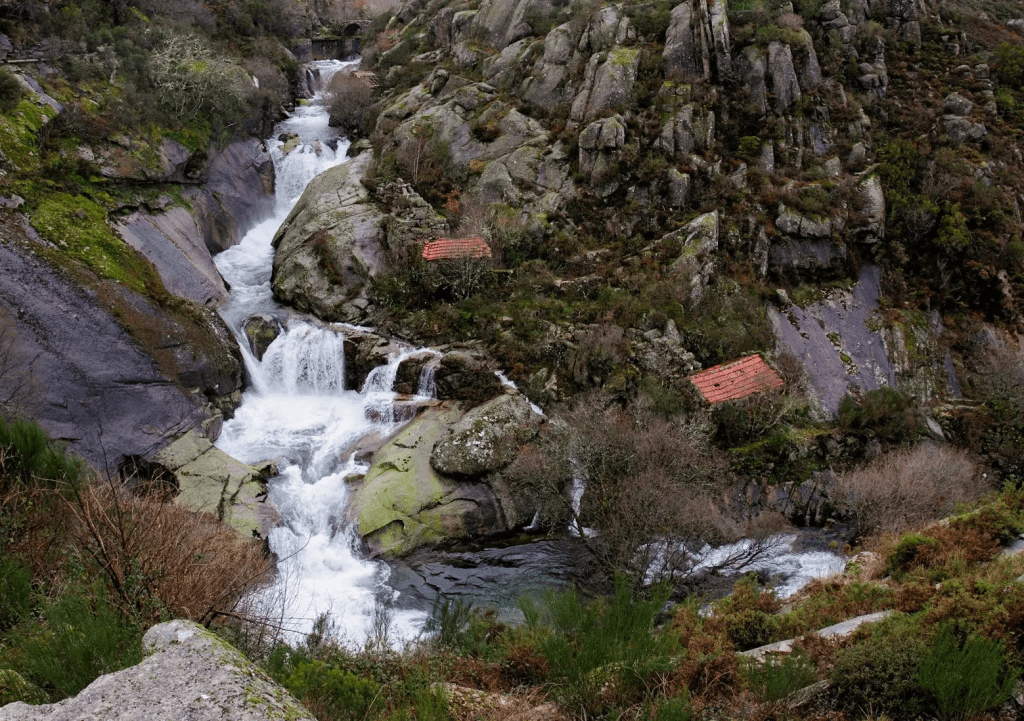
High on the granite shoulders of northern Portugal, where mist curls around jagged peaks, lies Castro Laboreiro—a village seemingly lifted from history. Nestled within Peneda-Gerês National Park, this small community has long guarded the frontier between Portugal and Spain. Today it feels like both a living village and an open-air museum, where ancient traditions endure in one of Europe’s last wild landscapes.
The Landscape: Portugal’s Wildest Edge
Arriving in Castro Laboreiro is like stepping back in time. The road climbs from the Minho valleys onto a plateau of granite boulders, windswept moors, and glacier-carved valleys. The striking scenery shifts in silver and gold light—green pastures dotted with heather and rocky outcrops.
Winter bites hard here, blanketing the mountains with snow and driving icy winds across the plateau. Spring brings carpets of wildflowers; summer returns shepherds to the upland pastures; autumn sets chestnut and oak forests ablaze. The seasons have long defined life in Castro Laboreiro, binding its people to the land.
It’s no accident the village was built here, so close to the clouds. The location is both strategic and symbolic: perched on the frontier where Portugal once defended itself against northern and eastern incursions.
A Fortress Above the Clouds
Commanding the skyline is Castro Laboreiro Castle, a ruined stronghold dating to the 9th century. Some say its origins reach back to the Romans, or even earlier Celtic tribes. Rising 3,389 feet above sea level, the fortress once bristled with towers and battlements, controlling the passage between Portugal and Galicia.
Climbing the steep path to its crumbling gates, it’s easy to picture sentinels bracing against the wind, scanning the horizon for approaching riders. The fortress has long since fallen into ruin, but its stones still echo with stories of war, rebellion, and survival. Today the castle is a lookout for hikers and dreamers alike, its sweeping views stretching across valleys into Spain—wild and untamed as they were a thousand years ago.
A People Shaped by Migration
The people of Castro Laboreiro are as resilient as their land. For centuries, they practiced a unique migratory lifestyle called transhumance. Families kept two homes: one in the village for winter, and another in the mountain pastures for summer. Each year they moved with their cattle, goats, and sheep, chasing fresh grazing land and shelter from the elements.
This rhythm of movement shaped not only daily life but also architecture. Wandering the village today, you’ll see stone cottages, barns built to withstand storms, and granaries on stilts known as espigueiros. Every structure is practical yet bears the imprint of centuries of inherited knowledge.
Though modern life has curtailed transhumance, its echoes remain. Some families still move their herds, now with trucks instead of footpaths. The seasonal cycle lingers as a living memory, a link between the present and ancestral ways of life.
Guardians of Tradition
Isolation has helped Castro Laboreiro preserve cultural traditions rare elsewhere in Portugal. Chief among them is the Castro Laboreiro Dog—an imposing, wolf-like breed native to the region. Bred to guard herds from predators and thieves, these dogs remain among the oldest and most iconic Portuguese breeds, their loyalty as enduring as the mountains themselves.
Festivals also keep tradition alive. Each April, the Feast of Nossa Senhora da Anunciada fills the village square with music, dancing, and processions. Catholic rites mingle with echoes of older, pagan rituals, while tables groan with food that unites families and neighbors.
Equally enduring are the oral traditions: tales of witches (meigas), lost travelers guided by phantom lights, and a belief that the land itself is alive with spirits. In a place where fog can erase the horizon within minutes, it’s easy to see why myth and reality blur together.
A Borderland of Conflict and Connection
History has rarely been peaceful here. As a frontier outpost, Castro Laboreiro was a crossroads for armies, smugglers, and rebels. Locals lived under the constant threat of raids, but the border also fostered exchange—goods, ideas, and even marriages passed between neighboring villages.
During Portugal’s wars with Spain, the community bore the brunt of violence. In the early 19th century, French troops swept through during the Peninsular War, leaving scars still remembered in folk songs. In quieter times, smuggling flourished—tobacco, livestock, and contraband slipping across the line under the noses of customs officers.
Today, under the Schengen Agreement, the frontier is open. Yet the sense of living on the edge of Portugal persists. Stand at the castle and gaze toward Galicia, and you feel both the separation and the kinship of two lands bound by history.
Life in Stone and Silence
To walk through Castro Laboreiro is to walk through stone. Cobbled streets thread between granite houses. Water spills from carved fountains. The Romanesque village church anchors the community, while small chapels watch over the surrounding hills.
Stone tells another story, too—of resilience. These homes were built to endure snow, wind, and time. Many stand abandoned, left behind as young people sought opportunities abroad or in the cities. Yet others have been lovingly restored, often as guesthouses for visitors drawn by the park’s wild beauty.
Silence dominates here. In winter, the village feels almost deserted, save for the smoke curling from chimneys. Elders gather at the café or community center, speaking in a thick northern dialect nearly impenetrable to outsiders. Life here is measured not by clocks but by seasons and the rhythms of the land.
Peneda-Gerês National Park: A Wilderness Sanctuary
Beyond the village sprawls Peneda-Gerês National Park—Portugal’s only national park and one of Europe’s biodiversity treasures. Wolves still roam these mountains, though sightings are rare. Golden eagles nest on cliffs, and wild Garrano horses graze the high meadows. Rivers carve deep valleys, tumbling into waterfalls like the Cascata do Laboreiro, where clear waters plunge into natural pools.
For hikers, the park is a paradise. Trails reveal Roman bridges, megalithic tombs, and stone shepherd huts. Traces of ancient trade routes connect Castro Laboreiro to a wider Iberian world.
Everywhere the wilderness asserts itself. Unlike much of Europe, this is not a domesticated landscape—it remains raw, rugged, and humbling.
Food of the Highlands
No portrait of Castro Laboreiro is complete without its food. This is mountain fare, hearty and honest, shaped by centuries of survival in harsh conditions:
-
Posta à Laboreiro: thick beef steaks grilled over open flames, often paired with potatoes and cabbage.
-
Cabrito assado: roasted kid goat, tender and herb-infused.
-
Fumeiro: smoked sausages and cured meats, a tradition of preservation still thriving.
-
Broa de milho: dense cornbread baked in wood-fired ovens.
Meals are communal, shared with neighbors and guests. And always there is wine from the Minho valleys—bright, crisp, and refreshing, a counterpoint to the richness of the food.
Why Castro Laboreiro Matters
In an age of rapid change, Castro Laboreiro offers something rare: continuity. Here, traditions still shape daily life. Culture and landscape remain inseparable. The frontier identity continues to define the community.
For visitors, it offers more than scenic beauty. It offers perspective: a chance to see how people adapted to extremes, how they built lives of meaning from land and stone.
Stand on the castle ruins at sunset, as the sky burns crimson over Portugal’s wild frontier, and you realize Castro Laboreiro is not just a village. It is a testament to endurance, memory, and the timeless dialogue between people and place.
Practical Information
Getting There: Castro Laboreiro is in northern Portugal’s Minho region, about a 2.5-hour drive from Porto. The nearest town is Melgaço. Roads are winding but scenic.
Where to Stay: Restored stone cottages and guesthouses offer rustic charm. Many feature fireplaces and serve traditional meals. Reservations are essential in summer.
Best Time to Visit: Spring (May–June) brings wildflowers and mild weather; autumn (September–October) paints the landscape gold. Winter can be magical, though harsh.
What to Do: Hike to the castle, explore Peneda-Gerês trails, visit waterfalls, learn about the Castro Laboreiro dog, and wander the stone streets.







